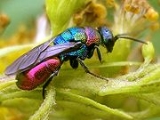
Chrysidinae
Encyclopedia
The subfamily Chrysididae contains those species that are most commonly recognized as cuckoo wasps, being by far the largest and most familiar subfamily. The group contains some 3000 species in 48 genera in 4 tribes worldwide. They are highly sculptured, with brilliantly colored metallic bodies, and capable of folding their bodies over (or, more commonly, rolling into a ball) as a defensive mechanism. They are most diverse in desert regions of the world, as they are typically associated with solitary bee
and wasp
species, which are also most diverse in such areas.
They are generally cleptoparasites, laying their eggs in host nests, where their larvae consume the host egg or larva while it is still young, then consuming the provisions. The other subfamilies are parasitoid
s, of either sawflies or walking stick
s.
They are among the few groups within the Aculeata
that cannot sting; the ovipositor is tube-like, and used to slip the eggs into the host nests. These wasps' only defenses, therefore, are passive; the heavily sculpted integument (which reduces the risk of being bitten or stung by an angry host), and their ability to cover up their vulnerable limbs and appendages when threatened by rolling up (much like a hedgehog
).
They have a characteristic "scurry and fly" search pattern when looking for hosts that is quite distinctive, even when seen from a distance. They land on a surface, typically either soil or wood, and scurry a short distance, in quick, hesitant spurts, with their antennae quivering vigorously as they go - and then they abruptly take off, typically only flying a short distance before landing again and repeating the maneuver.
Bee
Bees are flying insects closely related to wasps and ants, and are known for their role in pollination and for producing honey and beeswax. Bees are a monophyletic lineage within the superfamily Apoidea, presently classified by the unranked taxon name Anthophila...
and wasp
Wasp
The term wasp is typically defined as any insect of the order Hymenoptera and suborder Apocrita that is neither a bee nor an ant. Almost every pest insect species has at least one wasp species that preys upon it or parasitizes it, making wasps critically important in natural control of their...
species, which are also most diverse in such areas.
They are generally cleptoparasites, laying their eggs in host nests, where their larvae consume the host egg or larva while it is still young, then consuming the provisions. The other subfamilies are parasitoid
Parasitoid
A parasitoid is an organism that spends a significant portion of its life history attached to or within a single host organism in a relationship that is in essence parasitic; unlike a true parasite, however, it ultimately sterilises or kills, and sometimes consumes, the host...
s, of either sawflies or walking stick
Walking stick
A walking stick is a device used by many people to facilitate balancing while walking.Walking sticks come in many shapes and sizes, and can be sought by collectors. Some kinds of walking stick may be used by people with disabilities as a crutch...
s.
They are among the few groups within the Aculeata
Aculeata
The name Aculeata is used to refer to a monophyletic lineage of Hymenoptera. The word "Aculeata" is a reference to the defining feature of the group, which is the modification of the ovipositor into a stinger . In other words, the structure that was originally used to lay eggs is modified instead...
that cannot sting; the ovipositor is tube-like, and used to slip the eggs into the host nests. These wasps' only defenses, therefore, are passive; the heavily sculpted integument (which reduces the risk of being bitten or stung by an angry host), and their ability to cover up their vulnerable limbs and appendages when threatened by rolling up (much like a hedgehog
Hedgehog
A hedgehog is any of the spiny mammals of the subfamily Erinaceinae and the order Erinaceomorpha. There are 17 species of hedgehog in five genera, found through parts of Europe, Asia, Africa, and New Zealand . There are no hedgehogs native to Australia, and no living species native to the Americas...
).
They have a characteristic "scurry and fly" search pattern when looking for hosts that is quite distinctive, even when seen from a distance. They land on a surface, typically either soil or wood, and scurry a short distance, in quick, hesitant spurts, with their antennae quivering vigorously as they go - and then they abruptly take off, typically only flying a short distance before landing again and repeating the maneuver.

